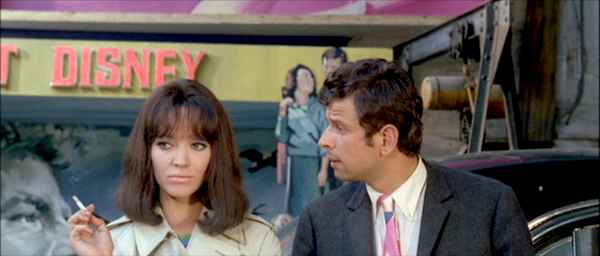|
Reviews of Recent Independent, Foreign, & Documentary Films in Theaters and DVD/Home Video

MADE IN U.S.A.
It’s that time of the year again: ‘tis the season for Rialto’s annual Godard rerelease. When asked to turn around a project—any project—in a hurry to ensure credit on New Wave producer Georges de Beauregard’s loans, resourceful Jean-Luc Godard came back from a bookstore hours later with their source material: a detective novel by Richard Stark, the pseudonym of recently deceased crime writer Donald E. Westlake. (Why haven’t you seen the film in America before now? De Beauregard never got around to acquiring the book rights for a full release.) In short, Godard, avid Maoist, conceived Made in U.S.A. to be a quick tax scheme. Enlisting Anna Karina to play a woman hunting for an honest explanation about her lover’s death, Godard reflects more on his relationship with his star than Stark’s murder mystery. “We were hardly seeing each other anymore,” explains Karina’s character, Paula. “I don’t even know whether I still love him, but I owed him something because of what was between us.” The camera tracks her pouts like a smart bomb. But, of course, Paula’s assassinated lover is also a communist. Her sleuthing shines a light on a network of American infiltrators tampering with justice in a fictional French town named Atlantic City. Bodies drop while Karina looks bored. Shot in color by legendary cinematographer Raoul Coutard, Made in U.S.A. is one of Godard’s most visually vibrant films. Modeling racks of mod clothing against bright backgrounds, Karina’s look later inspired a clothing line by French designer agnčs b. Paralleling Paula’s murder mystery with accusations of French and American involvement in the 1965 death of Marxist icon Mehdi Ben Barka, Godard turns contemporary politics into film noir. Barring one scene marveling that a cafe can conceptually be a restaurant, a bar, and a room all at the same time, the film sticks to overt political criticism of leftist in-fighting and the obsessive missives of young rebels. What does Godard believe is made in the U.S.A.? Evil—and a knack for aggressively exporting it like any other capitalist exchange. Rushed but
concise, Made in U.S.A. allowed the director to express anxiety
as in few other films. With no budget, a cast of pro-bono volunteers,
and a time crunch—not to mention he was concurrently filming Two or Three Things I Know About Her and had recently
divorced Karina—Godard pushed out a fast-paced film that sticks to his
plot. A structured storyline is rare for the director, perhaps making
the film an easy introduction to Godard for new viewers.
Zachary Jones
|

